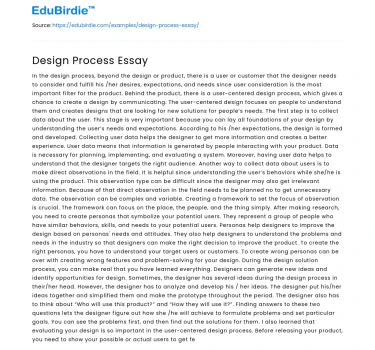In the design process, beyond the design or product, there is a user or customer that the designer needs to consider and fulfill his /her desires, expectations, and needs since user consideration is the most important filter for the product. Behind the product, there is a user-centered design process, which gives a chance to create a design by communicating.
The user-centered design focuses on people to understand them and creates designs that are looking for new solutions for people’s needs. The first step is to collect data about the user. This stage is very important because you can lay all foundations of your design by understanding the user’s needs and expectations. According to his /her expectations, the design is formed and developed. Collecting user data helps the designer to get more information and creates a better experience. User data means that information is generated by people interacting with your product. Data is necessary for planning, implementing, and evaluating a system. Moreover, having user data helps to understand that the designer targets the right audience. Another way to collect data about users is to make direct observations in the field. It is helpful since understanding the user’s behaviors while she/he is using the product. This observation type can be difficult since the designer may also get irrelevant information. Because of that direct observation in the field needs to be planned no to get unnecessary data. The observation can be complex and variable. Creating a framework to set the focus of observation is crucial. The framework can focus on the place, the people, and the thing simply.
Save your time!
We can take care of your essay
- Proper editing and formatting
- Free revision, title page, and bibliography
- Flexible prices and money-back guarantee
After making research, you need to create personas that symbolize your potential users. They represent a group of people who have similar behaviors, skills, and needs to your potential users. Personas help designers to improve the design based on personas' needs and attitudes. They also help designers to understand the problems and needs in the industry so that designers can make the right decision to improve the product. To create the right personas, you have to understand your target users or customers. To create wrong personas can be over with creating wrong features and problem-solving for your design.
During the design solution process, you can make real that you have learned everything. Designers can generate new ideas and identify opportunities for design. Sometimes, the designer has several ideas during the design process in their/her head. However, the designer has to analyze and develop his / her ideas. The designer put his/her ideas together and simplified them and make the prototype throughout the period. The designer also has to think about “Who will use this product?” and “How they will use it?”. Finding answers to these two questions lets the designer figure out how she /he will achieve to formulate problems and set particular goals. You can see the problems first, and then find out the solutions for them.
I also learned that evaluating your design is so important in the user-centered design process. Before releasing your product, you need to show your possible or actual users to get feedback. İt is really beneficial to get feedback and improve your design based on potential users’ feedback.
The product can be evaluated by its “effectiveness” and “efficiency”. I learned that you can make your design prototype from anything; it can be made from paper to scale of your product since the main point of making a product is to show your ideas to discuss with stakeholders and make them understand more about your product.
By testing your prototype, you can evaluate several points of your design; for example, you can get a chance to evaluate vague requirements, test the product’s feasibility or test some of the design points. By creating qualitative and quantitative usability metrics, designers can understand what will be worked and what won’t be worked. Quantitative data can be turned up into numbers. For example, users’ age and duration of the interview. On the other hand, qualitative data cannot be translated to numbers, for example, the user’s gender, interview transcript, or images.
Besides conceptual design (data, environmental, usability, user experience), the designer has to evaluate the concrete of design. The components of the concrete design are the visual appearance of the product including the fonts, graphics, interface layouts, choice of interaction device, buttons, and many of them.
I believe that user-centered design has several benefits for designers. First of all, thanks to the research phase, user needs, and demands are learned and understood by the designer. Moreover, creating personas is a good way to define requirements. Unrealistic goals can be eliminated by evaluating the design and creating design solutions processes. By focusing on users’ needs and expectations, the product is formed accurately. To understand the problem space and conceptualize the interaction augment the percentage of getting there. I believe that the key principle of user-centered design can be not to be afraid of designing what you want by considering users’ needs and creating your possible personas to improve your design. Meeting users’ expectations and making your prototype can be very beneficial to getting feedback quickly. The designer should iterate the prototype of the design. Getting feedback from your real user might also be considered as decreasing errors. Overall, good user-centered design products have similar interface design points. They do not have lots of unnecessary features. The home pages of the designs are clear, they are easy to understand. They do not make any confusion over how to transfer from one page to another. Simplicity is also the main point of successful user-centered designs. Simplicity can be explained with clean, smooth, and straightforward website pages. In addition, the user needs to feel that she/he owns control over the website or product.






 Stuck on your essay?
Stuck on your essay?

